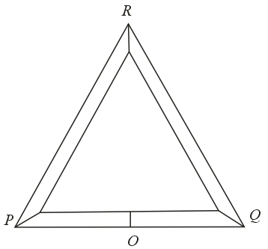In two experiments with a continuous flow calorimeter to determine the specific heat capacity of a liquid, an input power of produced a rise of in the liquid. When the power was doubled, the same temperature rise was achieved by making the rate of flow of liquid three times faster. Find the power lost (in ) to the surrounding in each case.

Important Questions on Thermometry, Thermal Expansion and Calorimetry
A clock with a metallic pendulum at runs faster by each day and at , runs slow by . Find the coefficient of linear expansion of the metal. (nearly in )
Two vessels connected at the bottom by a thin pipe with a sliding plug contain liquid at and respectively. The coefficient of cubic expansion of liquid is . The ratio of heights of liquid columns in the vessel is nearest to which integer?
Three rods of equal length are joined to form an equilateral triangle . is the mid point of . Distance remains the same for small change in temperature. Coefficient of linear expansion and is the same, i.e., but that for is . Then find the ratio .

We would like to increase the length of long copper rod of cross section by . The energy absorbed by the rod if it is heated is . The energy absorbed by the rod if it is stretched slowly is . Then, find the value of . [Various parameters of copper are density, thermal coefficient of linear expansion, Young’s modulus , specific heat]
A rod has variable co-efficient of linear expansion . If length of the rod is . Determine increase in length of the rod in on increasing temperature of the rod by

A clock pendulum made of invar has a period of at . If the clock is used in a climate where average temperature is , what correction (in seconds) may be necessary at the end of days to the time given by clock?
The temperature of a body rises by when a certain amount of heat is given to it. The same heat when supplied to of ice at , raises its temperature by . Find the water equivalent of the body in grams [Given: and ]
